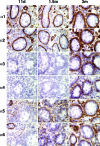Sequential expression of type IV collagen networks: testis as a model and relevance to spermatogenesis
- PMID: 16651625
- PMCID: PMC1606577
- DOI: 10.2353/ajpath.2006.050816
Sequential expression of type IV collagen networks: testis as a model and relevance to spermatogenesis
Abstract
The six alpha chains of type IV collagen are organized into three networks: alpha1/alpha2, alpha3/alpha4/alpha5, and alpha1/alpha2/alpha5/alpha6. A shift from the alpha1/alpha2 to the alpha3/alpha4/alpha5 network occurs in the developing glomerular basement membrane, but how the alpha1/alpha2/alpha5/alpha6 network fits into this sequence is less clear, because the three networks do not colocalize. Here, we studied the seminiferous tubule basement membrane of normal canine testis where all three networks do colocalize: the alpha1/alpha2 network is expressed from birth, the alpha1/alpha2/alpha5/alpha6 network by 5-6 weeks of age, and the alpha3/alpha4/alpha5 network by 2 months of age. A canine model of Alport syndrome allowed study of the absence of alpha3/alpha4/alpha5 and alpha1/alpha2/alpha5/alpha6 networks in testis. In Alport dogs, the seminiferous tubule basement membrane was thinner than in controls. Spermatogenesis began at the same time as with normal dogs; however, the number of mature sperm was significantly reduced in Alport dogs. Thus, it would appear that alpha3/alpha4/alpha5 and alpha1/alpha2/alpha5/alpha6 networks are not essential for onset of spermatogenesis, but long-term function may be compromised by the loss of one or both networks. This situation is analogous to the glomerular basement membrane in Alport syndrome. In conclusion, testis can serve as a model system to study the sequence of type IV collagen network expression.
Figures







Similar articles
-
Regulation of collagen type IV genes is organ-specific: evidence from a canine model of Alport syndrome.Kidney Int. 2005 Nov;68(5):2121-30. doi: 10.1111/j.1523-1755.2005.00668.x. Kidney Int. 2005. PMID: 16221211
-
Type IV collagen of the glomerular basement membrane. Evidence that the chain specificity of network assembly is encoded by the noncollagenous NC1 domains.J Biol Chem. 2000 Sep 29;275(39):30716-24. doi: 10.1074/jbc.M004569200. J Biol Chem. 2000. PMID: 10896941
-
The NC1 domain of collagen IV encodes a novel network composed of the alpha 1, alpha 2, alpha 5, and alpha 6 chains in smooth muscle basement membranes.J Biol Chem. 2001 Jul 27;276(30):28532-40. doi: 10.1074/jbc.M103690200. Epub 2001 May 25. J Biol Chem. 2001. PMID: 11375996
-
Organization and expression of basement membrane collagen IV genes and their roles in human disorders.J Biochem. 1998 May;123(5):767-76. doi: 10.1093/oxfordjournals.jbchem.a022003. J Biochem. 1998. PMID: 9562604 Review.
-
Collagen IV diseases: A focus on the glomerular basement membrane in Alport syndrome.Matrix Biol. 2017 Jan;57-58:45-54. doi: 10.1016/j.matbio.2016.08.005. Epub 2016 Aug 27. Matrix Biol. 2017. PMID: 27576055 Free PMC article. Review.
Cited by
-
Screening of Integrin Heterodimers Expressed Functionally on the Undifferentiated Spermatogonial Stem Cells in the Outbred ICR Mice.Int J Stem Cells. 2020 Nov 30;13(3):353-363. doi: 10.15283/ijsc20061. Int J Stem Cells. 2020. PMID: 32840227 Free PMC article.
-
A Nonsense Mutation in COL4A4 Gene Causing Isolated Hematuria in Either Heterozygous or Homozygous State.Front Genet. 2019 Jul 2;10:628. doi: 10.3389/fgene.2019.00628. eCollection 2019. Front Genet. 2019. PMID: 31312213 Free PMC article.
-
Temporal maturation of Sertoli cells during the establishment of the cycle of the seminiferous epithelium†.Biol Reprod. 2024 Oct 14;111(4):959-974. doi: 10.1093/biolre/ioae115. Biol Reprod. 2024. PMID: 39077996 Free PMC article.
-
An intracellular trafficking pathway in the seminiferous epithelium regulating spermatogenesis: a biochemical and molecular perspective.Crit Rev Biochem Mol Biol. 2009 Sep-Oct;44(5):245-63. doi: 10.1080/10409230903061207. Crit Rev Biochem Mol Biol. 2009. PMID: 19622063 Free PMC article. Review.
References
-
- Hudson B, Reeders S, Tryggvason K. Type IV collagen: structure, gene organization and role in human diseases: molecular basis of Goodpasture and Alport syndromes and diffuse leiomyomatosis. J Biol Chem. 1993;268:26033–26036. - PubMed
-
- Hudson B, Tryggvason K, Sundaramoorthy M, Neilson E. Alport’s syndrome, Goodpasture’s syndrome, and type IV collagen. N Eng J Med. 2003;348:2543–2556. - PubMed
-
- Gunwar S, Ballester F, Noelken M, Sado Y, Ninomiya Y, Hudson B. Identification of a novel disulfide-cross-linked network of α3, α4 and α5 chains of type IV collagen and its implications for the pathogenesis of Alport syndrome. J Biol Chem. 1998;273:8767–8775. - PubMed
-
- Sado Y, Kagawa M, Naito I, Ueki Y, Seki T, Momota R, Oohashi T, Ninomiya Y. Organization and expression of basement membrane collagen type IV genes and their roles in human disorders. J Biol Chem. 1998;123:767–776. - PubMed
-
- Borza D, Bondar O, Ninomiya Y, Sado Y, Naito I, Todd P, Hudson B. The NC1 domain of collagen IV encodes a novel network composed of the alpha 1, alpha 2, alpha 5, and alpha 6 chains in smooth muscle basement membranes. J Biol Chem. 2001;276:28532–28540. - PubMed
Publication types
MeSH terms
Substances
Grants and funding
LinkOut - more resources
Full Text Sources

